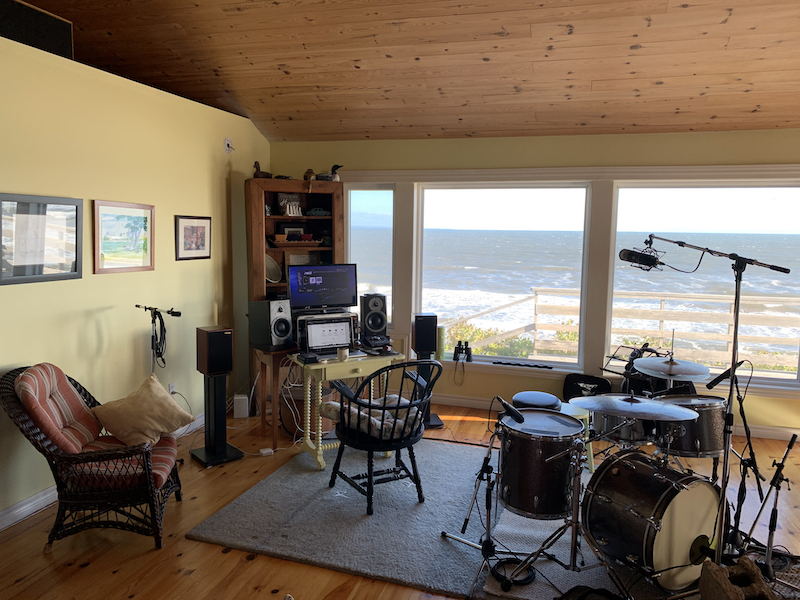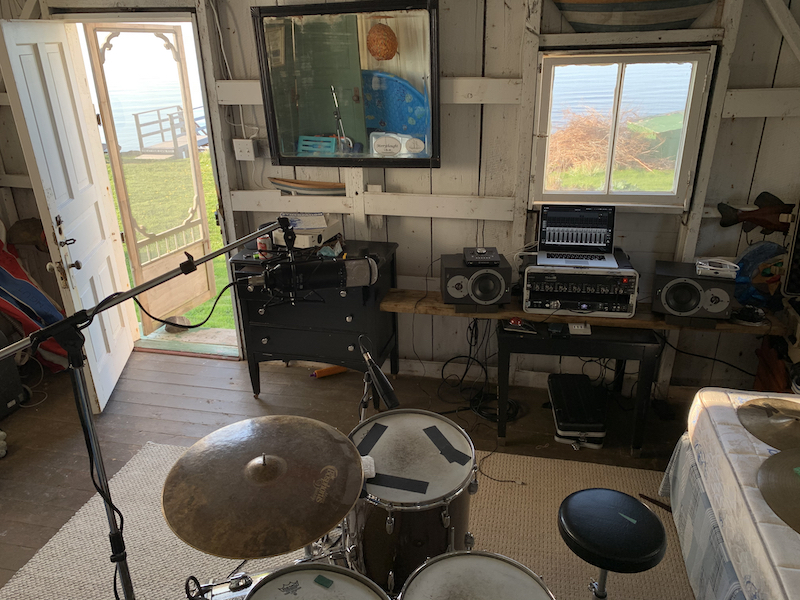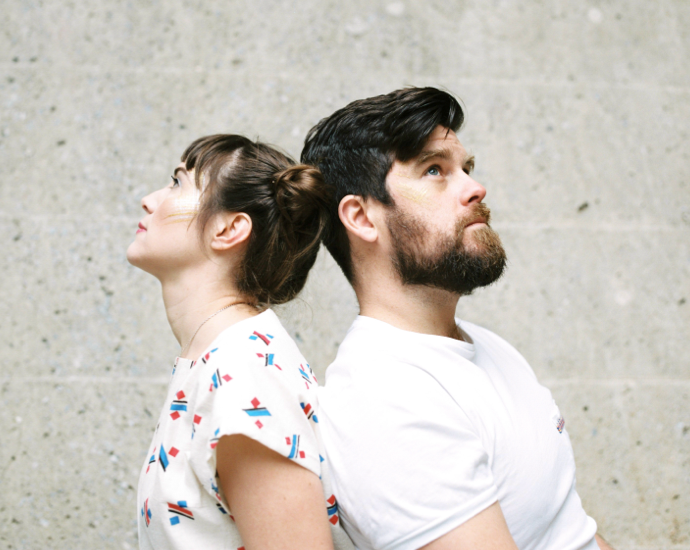Digging into the creative process, Byta speaks with artists, musicians, producers, DJs and anyone involved with music creation. A conversation about how they create, collaborate and share music. From studio setups to routines, and the first person to hear about the next 'big' work.
Where are you based?
Language Arts is based in Mi’kma’ki (or Nova Scotia, Canada).
How, when and where did you start making music? Are you primarily a musician or a producer, or do something else?
I was enrolled in Music for Young Children at the age of 3, to help spend some of my hyperactivity. I started training on the classical guitar at 12 years old. My bandmates Neil MacIntosh (drums), Chris Pruden (synth bass, keys), and Patrick O’Reilly (guitar) also played music early.
Who would you consider some of your biggest influences when it comes to your “sound”?
I absolutely adore Stereolab. Their energy is something I try to channel but I think our songs are a little too intense. Particularly so when it comes to content and the weight of it. I think in general, being classically (me) and jazz trained (Neil, Chris, and Pat), we feed off each other’s strengths. We push each other out of our comfort zones -when it comes to creating the live performance.
Explain your creative process. Do you have a routine?
I have been writing the music, words, and arrangements. I usually collect ideas over time when they pop into my head. Then I store them on manuscripts or on voice notes. When I have a chance to sit down with my guitar, I loop the general progression to see if and how the melody fits. I will then jam over top to write the other instrument’s parts. When I get to a place where it has come together and the words fit (sometimes they are written simultaneously), it usually is the majority of the finished composition. I don’t spend more than 30 mins exhausting a song idea. That way I don’t overthink the process.
I bring the song and arrangements to rehearsal and share them with the band. They lift the parts to make them sound like their part in Language Arts. We generally have an idea for the recordings that are different from the live show. This keeps things interesting and immersive for our listeners.
I tend to get ideas at the most inopportune times. This could be when I am drifting off to sleep, walking my dogs, in a meeting, or rushing to the washroom. I have many voice notes on my phone, for example, that are so quiet and huffy. I am trying not to lose the idea or have anyone nearby hear what I am singing due to embarrassment. However, when I go back to explore them, I end up laughing because they are almost inaudible.
What is your “studio” setup?
I am going to leave this to our Grammy-winning bandmate Neil MacIntosh who produced our 2015 album Able Island, and has engineered many of our records…
Neil: My studio set-up is primarily focused on having a strong remote capacity along with modular elements to suit the demands of particular scenarios. The Apollo series interfaces have become an industry-standard in terms of software processing & hardware emulation. Combined with excellent clocking, conversion and a robust monitoring section they’re ideal tools for my work. In addition to these interfaces, I use a Cranborne 500 ADAT expander as an analog FX/mix bus chain. Another extremely flexible and portable device that integrates seamlessly with the Apollos, the Cranborne provides 500 series analog FX processing, expanded I/O channel count, and an 8-channel analog summing mixer all without the hassle of a patch bay as all signal routing happens digitally via ADAT.
I’ve found introducing some analog flavour into my workflow has been very rewarding. It started with the addition of ‘colour’ saturation circuits from a company called DIYRE. They’re fun and simple soldering projects that build emulations of classic audio circuits. The intention is to subtly impart or exaggerate saturation (that magical analog sauce) that makes historic gear so coveted. These units along with a stereo EQ and compressor combine to form a bus processing chain. Combined with the Cranborne, this provides access to analog sound with modern digital routing flexibility.
Another essential piece of gear I use on almost all recordings is the L22 Sphere stereo microphone from Townsend Labs. This is a swiss army knife of large diaphragm condensers. It is both a stereo and mono mic along with many other useful features. The L22 is paired with software to emulate classic mics from the lockers of famous engineers. This option is great, however, the real advantage I’ve found with this mic is the ability to adjust the polar response after tracking. As I often record in live environments, accurately monitoring signals can be difficult and unpredictable. Having the flexibility to adjust polarity parameters afterwards can help reduce unwanted bleeding, enhance or shrink the stereo width, or dial in the perfect level of Omni response to the signal.
As I am mostly focused on location recording I don’t often find myself working in traditional studios. I’ll often book a day or two for final mixes of larger projects. Primarily, though, most of my mixing happens at home. In the spring of 2020, I retreated to a family cottage overlooking the Northumberland Strait in NS. From there I set up my drums and gear and began a series of recording and mixing projects.
Cottage recording has become a bit of a niche for me. I felt right at home set up in my childhood paradise. Acoustically, the space was quite forgiving for mixing and complementary for recording. It features a large communal kitchen/living space with an apexed, pyramid-shaped roof. That certainly helped with the diffusion of sources (particularly great on electric guitar cranked!).
An additional detached cabin which originally served as a horse stable 100+ years ago also provided a great space for recording drums (Griffith/Hiltz trio’s record Arcade). Rough-hewn, century-old lumber provided adequate defence against flutter and resonance. They don’t, however, do much to quell the urges of my retired neighbour. They threatened to drag the whole cabin into the ocean with his tractor if I continued my quest for the perfect take. As much as I have praise for the inadvertent acoustics of such places, there are always issues that arise and particularly so with monitoring.
To address these issues and accommodate my nomadic style, Sonarworks Reference room measurement software has become another essential tool. It can’t solve time domain problems. However, it can make a huge difference with an unfamiliar space and/or speakers and become a reliable monitoring tool. Along with high-quality open-back planar headphones and mixing-focused, flat-response IEMs I feel I have adequate monitoring. Allowing me to make accurate mixing decisions in any location.


What is your process when working with other people? How is collaboration different in the studio vs working remotely?
Kristen: There is never one uniform process. We usually get together socially and explore our shared interests. We form a solid friendship before partnering with anyone that has worked with Language Arts. On our last record, it started that way with both producers (David Bottrill and Joel Stouffer). I shared the tracks and my visions for them. I also referenced sound treatments from other recordings.
The Sprout song, for example, starts with tremolo banjo, which I play. I asked my bandmate to record it and reverse the sound. Then he added nice gates to that and we made that into the intro. When we got into the studio with Joel, we thought the intro needed a woosh-type of sound to really crack in the song. We looked around and Neil screwed the legs off of the Wurlitzer and crashed them together. We then reversed that sound, and that is what you hear, bringing in the guitar and vocals. Joel liked the intro so much that we didn’t want to add too much more.
To make the song more intimate, we decided to record my guitar parts on my classical guitar. We mic’ed my guitar and the room to get those parts. Also, we used the pick-up on my guitar so that when we transition to the bombastic ending. Going to electric guitar would be less jarring.
Because both Joel (producer) and Neil (bandmate) are drummers, they toyed with playing “prepared drums”. This means that many different objects were clipped to the drum skins to resonate different sounds. Those preparations made for the jangly shuffle that you can hear. The drums have a loose feel, just slightly behind the beat in a stylistic way.
The bass was pretty straightforward. I recorded the electric bass and then Chris doubled it on his voyager synth. That way Joel could play with both, blending and separating them.
My guitars are coming through numerous pedals. These manipulate the sound with reverb, delay, modulation, octaves, a synth driver, and some grit to build up. Finally, my vocals were recorded in my practice space at home. I sang directly into a basic mic and then I was mic’ed with Neil’s 360 mic. Joel recorded me at a couple of different proximities to get the right tone for each section. We overdubbed a round to build tension at the start of the outro.
The whole process came quite naturally to us because we had a solid song. It was guiding us on where we wanted to go and how we wanted to bring those sounds to life. It’s so important to work with people you genuinely love hanging out with. Then the process feels right and the end product is something worth celebrating.
Neil [as a musician and producer]: My process when working with new clients/bandmates/musicians largely depends on the role I’m taking in the project. As a performer in the writing process, I typically take a production and arrangement role. I enjoy shaping the development of fresh ideas. There’s something very special in the serpentine nature of how compositions become realised. Often stiff and uncertain at first, they (hopefully) transition and blossom. Simultaneously featuring both the uniqueness of the performers and their ambitions of cohesion. Recently, a Language Arts composition developed from the sampling of bird calls from field recordings. These were subsequently auto-tuned, midi quantized, and then entered into various soft synths and drum machines. Often the first step is the most difficult in composition. As such having various strategies to inspire creative energy can be very helpful.
As an Engineer, I like to talk with the performers about previous recording experiences on the instrument. What mics, preamps, placement and acoustic setting they prefer in addition to any references might be relevant. Most professional musicians have a surprising amount of insight into the recording process and I really enjoy collaborating and learning new skills, especially for unfamiliar instrumentation. This routine can save a lot of time, expedite the experimenting process and get to the music-making more quickly. In both roles I find references to be the most useful strategy to achieve the desired result. I’ve been using the software ADPTR Metric A/B as a reference switch. In addition to other analytic features like dynamic range, loudness and phase correlation, it provides an ergonomic and convenient way to reference multiple different samples against your active mix.
Collaboration in the studio is quite a bit more fluid than in a remote session. Nothing can ever replace the magic of musicians performing in the same physical space. There is instant feedback and the more subtle human behaviour is communicated and understood better. However, as no one’s diet, stamina and physical location are the same, in-person sessions can stretch the emotional capacity, patience and finances of individuals. Remote recording can offer a reprieve from these stresses, at the expense of time, human connection and recording quality.
Technical coordination beforehand is extremely important to match sample rates, bit depth, tempos and software in order to avoid sync issues that are a pain to fix and not easy to recover from in the early stage of a recording. Working from the same DAW is a must if the session is collaborative and coordinating file naming conventions can save a lot of headaches. Last winter I was mixing a collaborative project between Alamo/Drafthouse Theatres and the GroundUP music artists who had scored new original music for public domain silent films. Mixing from the family cottage in NS, I would facilitate mix revisions using video conferencing combined with a plugin from a company called Audiomovers. This plugin enabled me to broadcast the DAW output in real-time at full bandwidth, while I would share my screen to coordinate revisions such as automation which is helpful to have a visual reference.
At what point(s) are you comfortable letting other people hear what you are working on?
Personally, I have no ego about my songs, although I used to when I was in my 20’s. Now, I will bring something forward that is in the works at any stage just to see if my bandmates like the energy of the song. I am willing to share it with the people in my life that I trust for giving me honest feedback.
Do you share your work in progress (streams or downloads)? Any technical frustrations?
Not necessarily. I think it is just too bad when there’s such a volume of releases coming out every day that otherwise amazing musicians could get buried under. Thus we release finished products, unless there is a reason to chronicle a process of demoing, or pre-production, to tell the story of how the song was composed and what it means to us all.
How do you know when a track/album is finished?
When everyone puts in their parts and we are clear that the sound isn’t too empty or too crowded; and that the overall song takes you somewhere with and without the magic of good production.
After we test out the mixes on all sorts of speakers and are satisfied with the balance, we bring it to the mastering engineer to make sure to emphasise the whole journey throughout the records. Our songs tend to be quite dynamic, meaning that we venture into peaks and valleys of sound and so the mastering can be challenging to capture that without overly compressing it.

How do you listen to the final mixes/mastered work?
Kristen: For mixes: On all speakers, car, phone, portable, computer, stereo, studio, and headphones. For masters: In the studio
Neil: As a performer/writer final mixes are typically sent to individuals to review at home and make notes. I like to listen to the mixes on as many sources as possible. My mixing rig, (active ported & passive sealed monitors), my home stereo, headphones, Bluetooth speaker, rental car (Dodge Durango!) and finally for the most disappointing and potentially heartbreaking edition, the dreaded smartphone. Does the emotion of the music translate across all devices? If not, how do you negotiate and find a balance between the sources? The listener never has an ideal set-up, and rarely cares so keeping that in mind helps find that sweet spot across all systems & mediums of playback.
After final mixes are approved, mastering session listens are usually at home or at the mastering studio if available. I think one of the best practices to really hear it objectively and enjoy your work is to take a break from it beforehand. I always seem to have a different reaction if I take a few weeks off (if possible). I’m particularly sensitive to tempos late in the mixing process, always regretting one section or another for being sluggish or rushed. However, if I can step away at the end and come back to it with fresh ears I’m most pleasantly surprised with the results.
How important is pre-release security when sharing new work?
Very important. We worked hard to get the song to where it is and have built a whole strategy around releasing it with our marketing and PR teams, so the debut of the song must be done within that strategic plan and not leaked before it is released. The amount of money, time, and planning that goes into putting out songs needs to be respected, so security is very important. Luckily we have had no horror stories!
Who on your team gets to hear the final versions first and why, what formats do they each need?
The people who get to hear the product in process and at the finish point before the album is complete are our family and close friends, bandmates’, musician peers, and the team behind the release plan.
Outside of your inner circle who are the people that will need to hear the new tracks next?
If we are expanding our team, we also provide a private link to share the album with relevant industry people who might be interested in working with us, or who are curious to hear where the sound is going on new work.
Anything you are working on, anyone you are working with and want to share?
We are working on a series of co-writes with the land, where we record sounds on the lands of Mi’kma’ki and use the patterns of animals, plants, and natural objects to determine melodies and rhythms and include the field recordings in the actual music to show how the writing was inspired. So far it is sounding magical! We are also working on coordinating an EP. It will be an international collaboration to have artists from all continents remix an LA song of their choice.
Language Arts on Bandcamp: https://language-arts.bandcamp.com/

